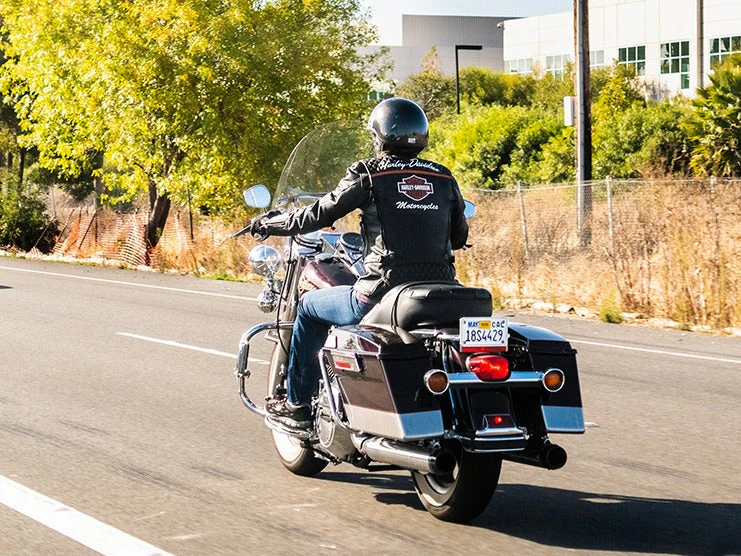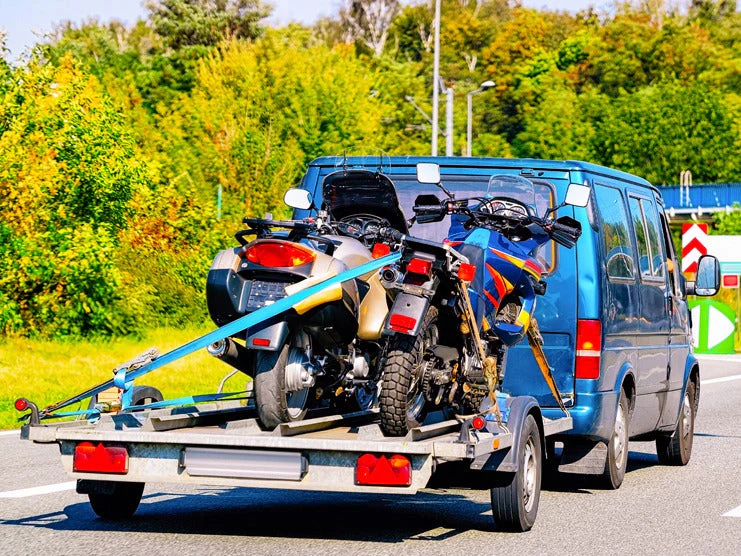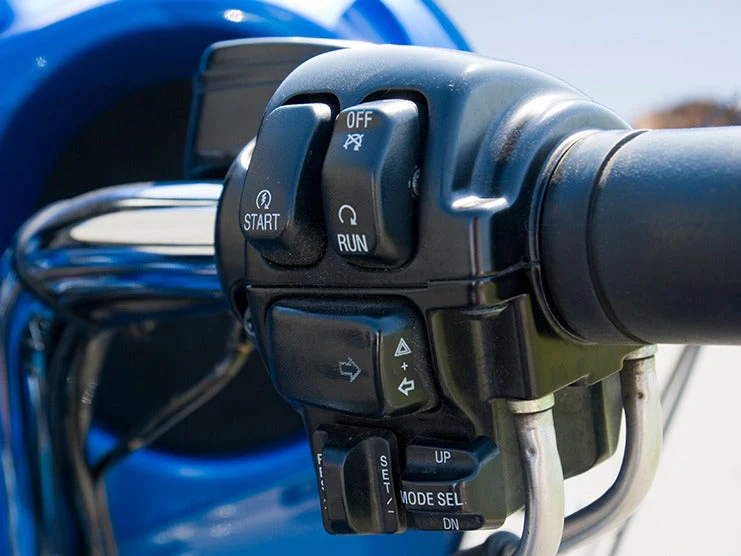High power generated by the engine ensures a smooth riding experience and the fuel, ignition, and intake systems function properly.
Any issues with these components can result in less power generated by the engine.
This article elaborates on the reasons why motorcycle engines lose power at high rpm.
Table of Content

1. How Does a Motorcycle Accelerate?
When twisting the throttle, the intake valve opens and allows more air to enter the engine. The air mixes with the fuel, which is then ignited by the spark plugs. Then the gasses created from combustion push the piston, causing the crankshaft to rotate. The crankshaft powers the transmission which transfers to the wheels and causes them to rotate.
2. Reasons Why Motorcycle Engines Lose Power at High RPM?
2.1 Clogged Fuel Injectors
Computerized fuel injection systems are used in modern bikes to deliver a precise amount of gasoline to the combustion chamber.
When pulling the throttle to inject fuel and increase your vehicle’s rpm, make sure the fuel injector is not blocked to ensure any loss of power.
Grit, rust, or contaminants that accumulate in the lines or travel through the fuel filter might block the tiny openings in these injectors.
Motorcycles with damaged or missing fuel filters are more likely to have clogged injectors.
If the injectors are clogged with debris, you can clean them by running an injector cleaner through the fuel system. Often, the cleaner is an additive that you mix in the fuel tank. Follow the manufacturer's recommendations for which cleaner to use to ensure the best results.
Also, you can prevent your motorcycle from losing power when accelerating by:
- Using only premium fuel based on manufacturer recommendations.
- Checking and changing the fuel filter based on the owner's manual's recommended maintenance plan.
2.2 Vacuum Leak
The ideal air-fuel mixture delivered to the engine is created inside the carburetor, which must remain completely sealed to function properly.
If excess air gets in through damaged gaskets or intake boots, the proportions of the air-fuel mixture will become unbalanced. This is called a vacuum leak.
A vacuum leak causes the carburetor to produce a disproportionate air-fuel mixture. An engine won't function properly if it takes in too much air that outweighs the gasoline. The more gas you put into the motorcycle, the more air will be drawn into openings, which can eventually cause the vehicle to lose power.
Check your carburetor's intake boots to make sure they are not cracked or have become brittle with age. Make sure that the intake boots' quick-release hose clamps are secure and do not let extra air enter. Replace the intake boots if they have suffered irreparable damage.
You should also check the carburetor's gaskets since they can also become cracked and brittle. Inspect them to ensure the seals between the sections are secure. Otherwise, replace them if they have suffered irreparable damage.
2.3 Extra Slack in the Throttle Cable
The throttle cable connects the throttle to the carburetor. Depending on how fast or slow your motorcycle is moving, the throttle cable will open and close the butterfly valve on the carburetor.
However, if the throttle cable has too much slack, the butterfly valve will not open fully when the throttle is pulled. The butterfly valve not opening or closing correctly will cause an uneven air-fuel mixture and result in a loss of power.
To check how well the butterfly valves operate, turn the throttle fully when the motorbike is off. If the valves don't fully open, there may be too much slack in the throttle cable.
The knob at the end of the throttle wire connected to the carburetor is secured by a nut. Try to tighten it more to reduce slack.
If you ride an older motorbike, the throttle cable will extend somewhat, and tightening won't help resolve the issue. You will need to purchase a new throttle cable.
2.4 Clogged Air Filters
An air filter is part of an air box unit that helps filter debris in the air that flows into the combustion chamber. Any disruption to the airflow results in an imbalanced air-fuel ratio that can affect the engine’s power output, especially at high rpm.
A clogged air filter will cause your motorcycle to consume more fuel despite producing less power. This is due to the clogged air filter restricting airflow, which causes more fuel to enter the combustion chamber.
An air-fuel ratio with more fuel than air can result in slower engine response and delayed timing.
Cleaning the air filters can help reduce the risk of engine problems.
- Some air filters made of metal mesh or foam are reusable. These filters can be cleaned, lubricated, and reinstalled on your motorcycle.
- Some bikes use disposable air filters that must be replaced when they become clogged.
2.5 Dirty Spark Plugs
Spark plugs can become covered in carbon, dirt, and oil buildup over time. Thankfully, there is a simple solution to this issue. You can clean or replace spark plugs to significantly improve performance.
Spark plugs need to be cleaned if the engine has difficulty running or lowers your vehicle’s top speed. You can clean the spark plugs by following these instructions.
- Remove the spark plugs.
- To clean the spark plugs, use a wire brush.
- Use gasoline to thoroughly clean the plugs of any debris.
- Before reattaching the spark plugs to the bike, let them dry fully.
- After reattaching the spark plugs, start the bike while parked to test its conditions.
2.6 Restricted Exhaust System
A restricted exhaust system can cause a loss of power when trying to accelerate. This occurs because the restricted passages cause the exhaust gasses to accumulate in the cylinders and prevent smooth airflow.
It is best to take your bike to a professional for a more thorough analysis if you believe there is a problem with the exhaust system.
Causes of a Restricted Exhaust System
- Clogged Header Pipe
- Clogged Muffler
- Blocked Catalytic Converter
- Cracked Header Pipe
Signs of a Restricted Exhaust System
- Reduced Acceleration
- Reduced Top Speed
- Excessive Heat in the Exhaust System and Engine
- Reduced Power
2.7 Faulty Fuel System
The ECU on fuel-injected bikes often includes a built-in limp mode to minimize engine damage or severe fuel system malfunctions.
Fuel and ignition systems have a network of sensors connected to the ECU. A motorbike enters limp mode if one of the sensors detects a critical failure or if the ECU loses connection to one of the sensors due to broken cables or sensor failure. Your motorcycle's engine power becomes restricted in this situation to reduce the risk of a collision.
Certain motorcycle ECUs enter limp mode due to a gasoline system failure and will prevent the bike from revving up to higher rpms.
In some cases, a broken sensor will need to be replaced to help the bike return to full power.
However, some motorcycles will continue to operate in limp mode even after a broken sensor has been fixed. In this situation, the ECU must be connected to and checked by a diagnostics machine.
An ECU limp mode might reduce engine power due to the following issues:
- Faulty Fuel System Sensor
- Faulty Fuel Pump
- Faulty Regulator
- Faulty Fuel Filter
2.8 Delayed or Advanced Ignition Timing
Combustion can occur early or late in the piston cycle if your motorcycle's ignition timing is off Moreover, this will result in the motorbike losing power at high RPM.
Advanced ignition timing can cause the engine to knock because the gasoline ignites before the piston cycles. A premature explosion can prevent a motorcycle from starting before it can rev up since it prevents the piston from moving freely.
Delayed ignition timing might fill the cylinder with excess gasoline that was not ignited, resulting in wasted fuel and inefficient fuel consumption that can reduce engine power and prevent the bike from running at its maximum rpm.
2.9 Leaking Air Intake System
A leaking air intake system can cause engine compression, loss of air pressure, and less air in the air-fuel ratio, resulting in losing the power of your motorcycle at high rpm.
An internal air leak can cause air to enter the fuel lines, resulting in a lean fuel mixture and reduced engine performance.
Air leaks can happen due to a faulty hose, gasket, seal, pipe, or line. It is possible to identify the air leak yourself with the help of equipment or get it repaired at a service shop or a dealership.
2.10 Faulty Ignition System
A damaged ignition coil, spark plug, or ignition lead are common reasons why motorbikes often lose power at high RPMs. During maintenance checks, be careful when inspecting, maintaining, and repairing the essential ignition system parts.
- Start by looking for scorch marks, wear, and tear, or discoloration on spark plugs based on the information provided by the service manual for your motorcycle’s make and model. If they have become worn down, replace the spark plugs.
- Check the ignition leads in case of corrosion due to riding in harsh weather or improper storage.
- Check the ignition coil, it causes your motorcycle to lose power at high RPMs when it’s worn out.
2.11 Carburetor Problems
A dirty or improperly adjusted carburetor can prevent the engine from getting the right air-fuel mixture. You can resolve this issue by cleaning and realigning the carburetor.
Though carburetors can have different designs, they all operate the same way. Air enters the carburetor, mixes with the fuel, and then travels into the engine.
The carburetor has many adjustable components, such as the main jet, air screw, pilot jet, and fuel screw. You can modify these components to better suit your riding style and the motorcycle you own. You can adjust the air-fuel mixture delivered to your engine by adjusting carburetor components.
2.12 Blocked Fuel Filter
If the motorcycle fuel filter is clogged with grime, corrosion, or carbon fuel deposits, it will prevent fuel from entering the combustion chamber.
When the fuel filter is clogged, less fuel can pass through the filter, and the combustion chamber becomes filled with air. This results in an unbalanced air-fuel ratio that could affect the engine’s power output.
You can clean or replace a fuel filter. However, replacing a fuel filter is cheaper and easier; if the filter is clogged, it’s better to replace it instead of wasting time trying to clean it.
3. Last Words
Issues with engine power can be a cause of frustration for any motorcycle rider. Several causes of reduced engine power at high rpm include clogged fuel injectors, vacuum leaks, clogged air filters, dirty spark plugs, faulty fuel system, delayed or advanced ignition time, leaks in the air intake system, a faulty ignition system, and carburetor problems. You can fix most of these issues at home. There is a complete range of aftermarket parts and luggage available at Viking Bags, including saddlebags, sissy bar bags, tour packs, handlebars, sissy bars, crash bars, fairings, seats, luggage racks, and saddlebags.













Leave a comment
All comments are moderated before being published.
This site is protected by hCaptcha and the hCaptcha Privacy Policy and Terms of Service apply.